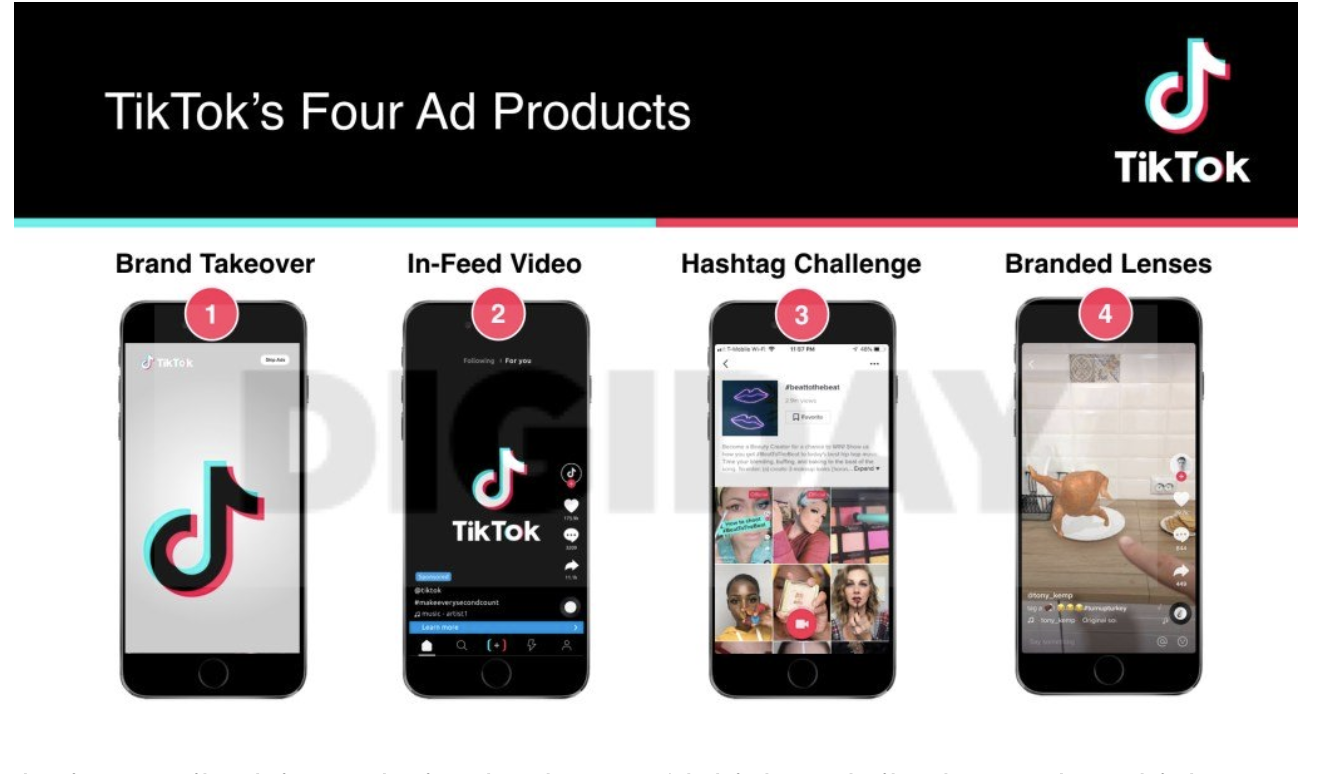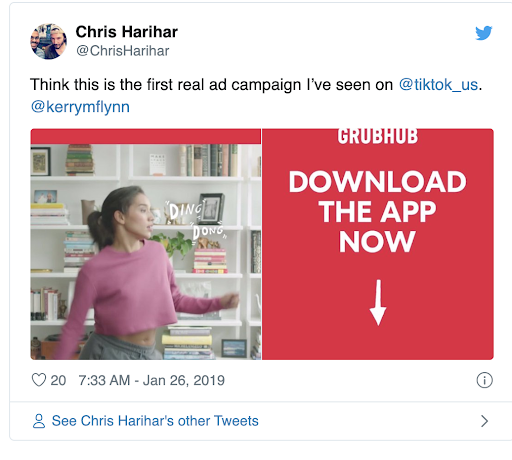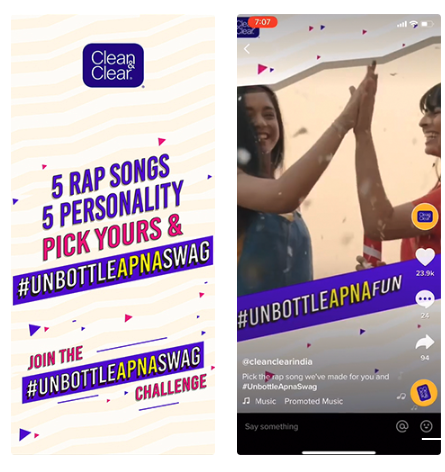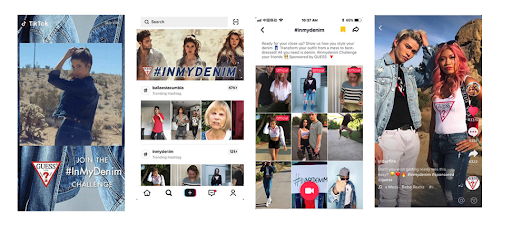What We’ll Cover:
- What is TikTok?
- An Overview of the TikTok Platform
- What Kinds of Brands Should Use TikTok?
- TikTok Marketing Strategies in Action
- How to Get TikTok Followers
- Influencer Marketing on TikTok
- Advertising on TikTok
What is TikTok?
TikTok is the fastest-growing social app on the market. Since its launch in 2016, it’s been downloaded 3 billion times.
The app’s extreme popularity makes it an obvious addition to most brands’ marketing strategies.
The caveat?
It’s a really young demographic; with the majority of users in the 18-24 age range. This means the content that performs well on TikTok might look a bit different from more traditional digital marketing channels.
While the platform represents a major opportunity to reach Gen Z consumers on their terms, brands need to be really deliberate in how they approach their marketing strategy.
The atmosphere is fun, informal, and largely positive, but brands unfamiliar with the territory risk “trying too hard” to be trendy. When you understand how TikTok marketing really works, you can avoid any potential faux pas.
An Overview of the TikTok Platform
Let’s start with a bit of background.
In 2018, a Chinese company called ByteDance acquired Musical.ly, a popular app where users (mostly teens and kids) could upload lip-syncing videos. ByteDance merged Musical.ly with its own app, another lip-synching platform, Douyin and rebranded under the name TikTok.
Both staff and users describe the app as a “positive, fun space” and a “collaborative” environment where just about anyone can go viral.
Yes, that means brands too.
But brands hoping to connect with younger customers need to understand the TikTok culture. TikTok is often compared to the bygone social app Vine, in that it’s considered more of an entertainment channel than a traditional social network.
According to Global Web Index, users say they like the app because it allows them to watch creative videos and offers a platform for creative self-expression.
The report also found that TikTok users value the entertainment aspect of the app more than things like the online community or the ability to stay in touch with friends.
Here are a couple of things you should know about how TikTok works:
The Basics
- Standard TikTok videos are 15 seconds long, but users can create multiple recordings inside the app and link them together.
- Users have the option to upload longer videos, but can’t record them directly inside TikTok and will need to use a third-party app instead.
- Users can live-stream content and access a range of tools, filters, and other effects that enhance the experience.
It’s AI-Driven and Personalized
TikTok’s algorithm is set up in a way that makes it easy for any user to go viral.
The app’s proprietary algorithm functions as a personalized recommendation engine, which serves up content based on what’s popular and what individual users like most.
If you’re interested in things like business or marketing or want to follow the latest current events, it doesn’t take long to create a personalized feed that matches your unique set of interests.
If you’re considering using TikTok to promote your brand, keep in mind that the platform doesn’t display content based on follower counts. Instead, it measures relevance by how well creators can tap into trends while carving out their own voice.
UGC (User-Generated Content) Rules in the “TikTok-Verse”
Adopting TikTok’s light-hearted vibe seems to be the key to connecting with users, regardless of age.
Where channels like Instagram have become more focused on curating a specific lifestyle, TikTok is about collaboration and authenticity.
It’s those brands that really know how to nail user-generated content and laugh along with their fans that see the most success.
What Kind of Brands Should Use TikTok?
The logical recommendation here is that TikTok is best suited to brands that cater to a younger demographic.
Even so, up to 20% of TikTok’s users are in the 40-49 age group bracket.
As you might imagine, consumer products are a natural fit for TikTok–think food, fashion, and beauty brands that perform well with younger consumers.
Still, just because the demographic skews young doesn’t mean that only youth-focused brands and entertainers can benefit from embracing TikTok as a marketing channel.
Traditional media outlets like The Washington Post, The Dallas Morning News, and NBC use TikTok to connect with a younger audience in a more authentic way.
Here’s a post from the Washington Post’s account, which uses the popular TV show The Office as inspiration for their behind-the-scenes material.
Reporters use the platform to show off their personalities in behind-the-scenes clips, and draw on pop-culture references to connect with the platform’s younger audience.
In doing so, it uses the app as a new way to keep the public informed and engaged in discussions of the latest events.
This is a perfect example of how an established brand can effectively use TikTok to connect with an entirely new audience.
Wondering how to work TikTok into your own strategy? Here are a few ideas.
TikTok Marketing Strategies in Action
Challenges, UGC (user-generated content), and influencer marketing are among the popular strategies brands are using to reach their audiences.
The entire basis for the platform revolves around different types of videos set to music, but that doesn’t mean you have to do it that way.
Influencers like The Rock and Gary Vee are using TikTok as they would Instagram.
Here’s a look at Gary Vee’s feed. You’ll notice his videos look similar to Instagram Stories, featuring text overlays that offer a few thoughts.
He’s not lip-synching, but he’s adapted his brand of content to the 15-second TikTok format.
Reverse Engineer What’s Working on Other Channels
While you need to learn the “rules of engagement” of the platform if you want to be successful, a lot of your successes on other social media channels can inform your TikTok strategy.
Like the Gary Vee example above, many brands will benefit from bringing what’s working on these channels, especially Instagram, to TikTok.
This is a good strategy to use when you’re first starting with TikTok to test the waters. From there, you can develop more specific strategies for the channel.
Here are a few things you might try:
- Use top-performing hashtags on Twitter or Instagram
- Repurposed content from Instagram Stories, IGTV, LinkedIn Live, YouTube, etc.
- Chop longer videos into TikTok’s 15-minute limit–if you’re reusing a longer YouTube video, that’s a lot of content.
Find TikTok Trends You Can Capitalize On
If you look at the Discovery section on TikTok, you’ll see a series of popular hashtags and the top posts in each of those categories.
Keep in mind, the hashtags represent the biggest trending categories, not necessarily the niche categories likely to perform best with your audience.
But, if you regularly post on Instagram and Twitter and use hashtags, enter your most popular hashtags into TikTok and see what pops up.
If there seems to be a lot of content around those tags, it’s a good sign that your social strategy could work on TikTok as well. Explore further with our TikTok video downloader.
How to Get TikTok Followers
There are several organic strategies you can follow to make a splash on the platform using the right tools and methods.
If you’re ready to expand your TikTok follower base, try one of these strategies today.
Use a Repeatable Format
Many of the most popular channels on TikTok use a similar format, theme, and idea for each new video.
This process builds anticipations with followers who are likely to revisit something that they enjoy or become curious about.
Even with a standard format, it’s still possible to incorporate impressive camera work, TikTok trends, and storytelling into each video. The idea is to use these features within a standardized template that viewers (or new followers) quickly learn to love.
Provide Answers to Audience Questions
Content creators on TikTok should always listen to the needs and interests of followers, especially if they want to understand what attracts new viewers to a channel.
Create videos that answer important questions viewers might have about your brand, or even about your growth on TikTok.
If you style and edit the video well, viewers may also have to watch multiple times so they can capture all the information. This has a positive effect on both your channel and ability to attract new followers.
Influencer Marketing on TikTok
Perhaps more so than any other social platform, marketers will benefit from influencer involvement on TikTok.
TikTok offers a Creator Marketplace to business users, allowing them to select influencer partners from the same platform where they set up their ads.
Of course, you can always find influencer partners on your own, but the benefit here is that you’ll be able to easily identify relevant influencers who already know the ins and outs of the platform.
It’s not clear how much these influencer efforts cost, but I’m willing to bet that it has something to do with reach and reputation, like any other social channel.
Let’s look at some examples of brands doing this well.
Peace Tea
Peace Tea teamed up with influencer Drea Knowsbest.
The video showcases Drea dancing with a can of tea against a series of summer-y backdrops.
The partnership was a smart move, as the post represents the content that tends to do well on the platform.
Plus, it’s fun to watch, which makes it a memorable brand awareness campaign.
Elf Cosmetics
Elf Cosmetics ran a TikTok campaign in August 2019 after discovering that #elfcosmetics already had 3.5 million views before the brand officially joined the app.
Recognizing the opportunity, the brand created an original 15-second song called “Eyes Lips Face” and enlisted the help of some platform influencers and famous faces like Reese Witherspoon, Jessica Alba, and Ellen DeGeneres.
The campaign generated a massive 20,000 user uploads using the song, drawing in a collective 2.3M views. It was such a success that the brand released a full version of the song on Spotify.
Chipotle
Chipotle has seen massive success on TikTok by running contests like #guacchallenge and the influencer-led #ChipotleLidFlip challenge, which encourages users to try a trick involving flipping the lid to a burrito bowl.
Here’s children’s musician, Dr. Jean demonstrating the #guacchallenge’s signature dance:
Kroger
Kroger was one of the first brands to test out TikTok’s shoppable ad campaigns.
The grocery chain created a challenge, #TransformUrDorm, targeted college students heading back to school.
The campaign leveraged influencers already familiar with the platform, garnered 854M views, and directed traffic to the brand’s website by allowing users to shop for dorm-friendly treats like granola bars and popcorn.
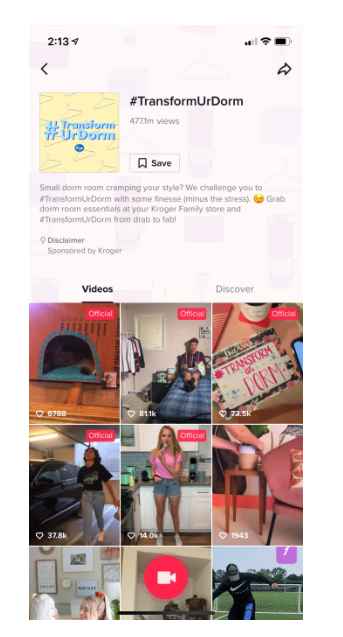
Kroger used TikTok to stage a hashtag challenge. Source
Advertising on TikTok
Advertising on TikTok has steadily increased since it arrived on the scene two years ago.
TikTok’s decision to allow advertising continues to suggest the platform’s suited for brands of all sizes.
User data also shows that TikTok audiences respond highly positively to advertising messages on the platform. High conversion rates mean TikTok is a major player in the social media advertising space.
To get the most from any TikTok ad campaign, you’ll need to know a few basic details about the options for running ads on the platform.
In Feed Advertising
In-feed ads are pretty versatile and look similar to an Instagram Story.
Brands also have the option to create shoppable in-feed videos, which allow them to add CTA buttons, links, and send users directly to a landing page to complete the purchase.
Advertisers can attach a URL to their video, much like Instagram Shopping posts, to direct users to their store. The benefit of using shoppable videos is that you can track the ROI of your marketing campaigns in a more direct way.
Traditional videos don’t offer this option. Instead, brands must rely on the familiar “link in bio” workaround we’ve all seen on Instagram.
Brand Takeovers
Brand Takeovers are ads that appear when a user opens the app and fills up the whole screen.
Here’s an example from GrubHub, which used the strategy to drive app downloads:
Branded Lenses
TikTok’s answer to the AR lenses found on Snapchat and Instagram, brands can pay for custom face filters, AR effects, and 3D objects.
Hashtag Challenges
One thing that’s immediately clear about TikTok is that its user base loves a hashtag challenge.
Among the best-known challenges is Jimmy Fallon’s #tumbleweedchallenge.
While the segment began on Fallon’s late-night show, it quickly became a TikTok staple. The challenge encourages users to upload videos of themselves rolling on the ground to Western music like a tumbleweed.
Paid advertisers can also get in on the hashtag challenge trend for a fast track to virality.
Here’s an example of Clean and Clear’s hashtag challenge, a campaign launched in India to promote their limited edition bottles. It features five unique personality types and five different songs.
The campaign targeted female teens and encouraged them to showcase their unique personalities in their own videos.
According to TikTok, the campaign generated 1.96 billion video views, 172 million likes, shares, and comments, and 2.62 million UGC posts to Clean & Clear’s official account.
Guess also did something similar.
The #InMyDenim Hashtag Challenge was designed to drive brand awareness ahead of the Fall 2018 back-to-school season.
The campaign centered around the idea of going from “mess” to “best dressed” and the brand posted several official videos to Bebe Rexha’s “I’m a mess.” They also enlisted the help of a few influencers to demo the concept and encourage users to participate.
The campaign generated 5,500 UGC videos, 12,000 new followers, and 10.5m video views.
Final Thoughts
TikTok presents a massive opportunity for brands to increase their reach.
However, it’s essential that you work hard to get to know the TikTok “culture.”
Many of the larger brands mentioned above have tapped influencers to help them run campaigns. This is a smart strategy, though it’s worth pointing out that these ad campaigns and the influencers that promote them can get expensive.
So, while larger brands have no problem accessing these tools, smaller brands may want to start off with organic strategies to test the TikTok waters.

